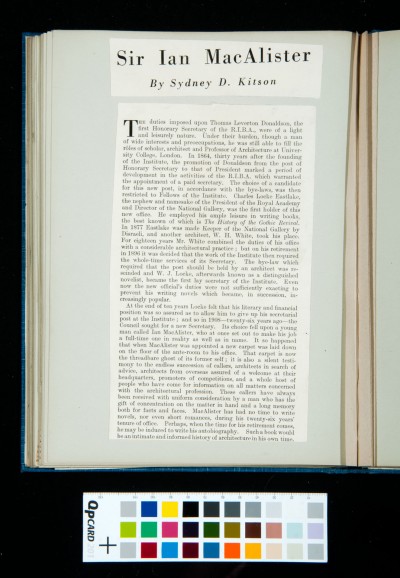Cotmania. Vol. IX. 1933-4
Archive: SDK Sydney Decimus Kitson Archive
Reference Number: SDK/1/2/1/9
Page: p. 25 verso
-
Description
Clipping of article by Sydney Kitson on Sir Ian MacAlister published in the Architecture Review. Article continues on p. 26 recto.
Architecture Review article
Date: 1933-1934
-
Transcription
{Architecture Review article}
Sir Ian MacAlister
By Sydney D. KitsonTHE duties imposed upon Thomas Leverton Donaldson, the first Honorary Secretary of the R.I.B.A., were of a light and leisurely nature. Under their burden, though a man of wide interests and preoccupations, he was still able to fill the rôles of scholar, architect and Professor of Architecture at University College, London. In 1864, thirty years after the founding of the Institute, the promotion of Donaldson from the post of Honorary Secretary to that of President marked a period of development in the activities of the R.I.B.A. which warranted the appointment of a paid secretary. The choice of a candidate for this new post, in accordance with the bye-laws, was then restricted to Fellows of the Institute. Charles Locke Eastlake, the nephew and namesake of the President of the Royal Academy and Director of the National Gallery, was the first holder of this new office. He employed his ample leisure in writing books, the best known of which is The History of the Gothic Revival. In 1877 Eastlake was made Keeper of the National Gallery by Disraeli, and another architect, W. H. White, took his place. For eighteen years Mr. White combined the duties of his office with a considerable architectural practice ; but on his retirement in 1896 it was decided that the work of the Institute then required the whole-time services of its Secretary. The bye-law which required that the post should be held by an architect was rescinded and W. J. Locke, afterwards known as a distinguished novelist, became the first lay secretary of the Institute. Even now the new official's duties were not sufficiently exacting to prevent his writing novels which became, in succession, increasingly popular.
At the end of ten years Locke felt that his literary and financial position was so assured as to allow him to give up his secretarial post at the Institute ; and so in 1908—twenty-six years ago—the Council sought for a new Secretary. Its choice fell upon a young man called Ian MacAlister who at once set out to make his job a full-time one in reality as well as in name. It so happened that when MacAlister was appointed a new carpet was laid down on the floor of the ante-room to his office. That carpet is now the threadbare ghost of its former self ; it is also a silent testimony to the endless succession of callers, architects in search of advice, architects from overseas assured of a welcome at their headquarters, promoters of competitions, and a whole host of people who have come for information on all matters concerned with the architectural profession. These callers have always been received with uniform consideration by a man who has the gift of concentration on the matter in hand and a long memory both for facts and faces. MacAlister has had no time to write novels, nor even short romances, during his twenty-six years' tenure of office. Perhaps, when the time for his retirement comes, he may be induced to write his autobiography. Such a book would be an intimate and informed history of architecture in his own time.
